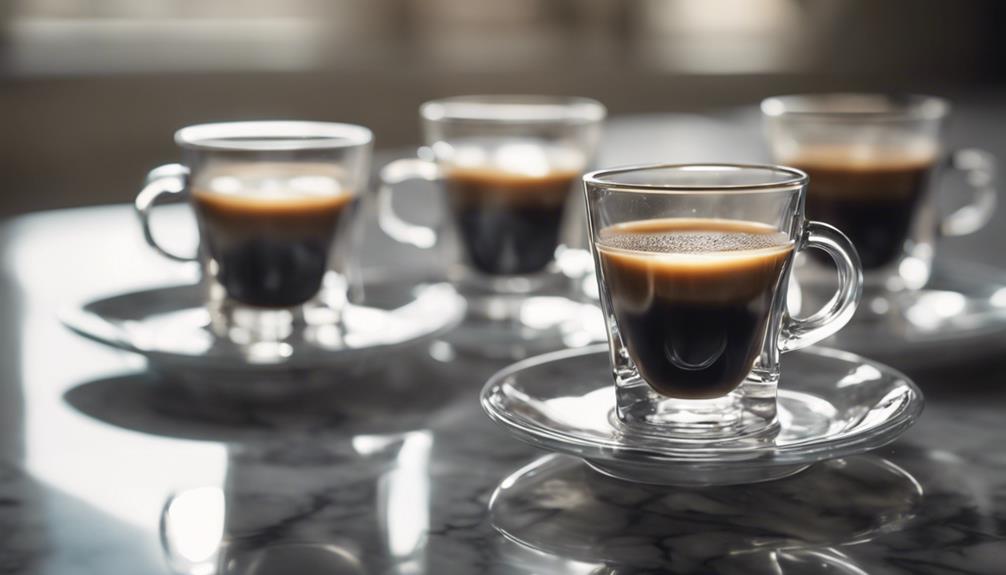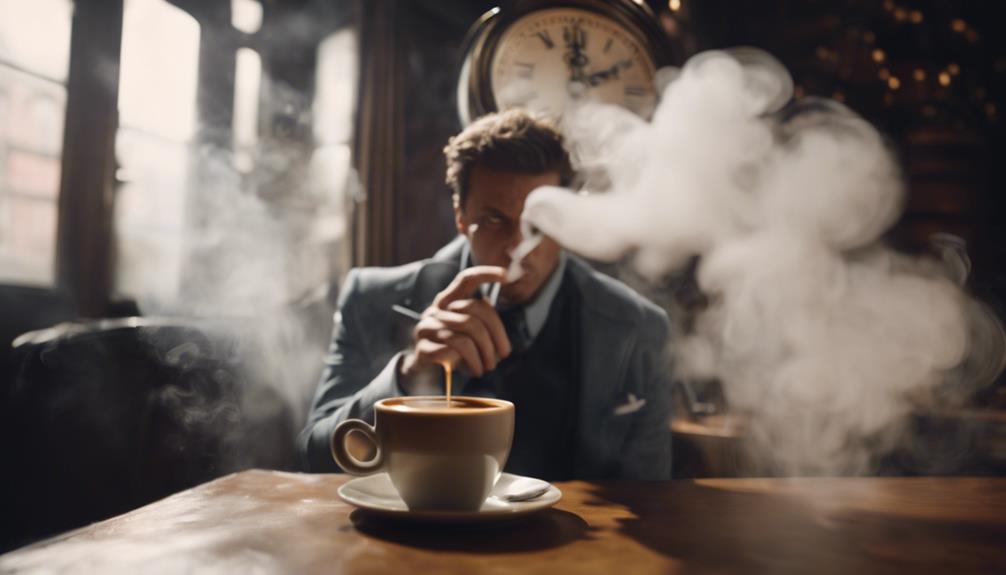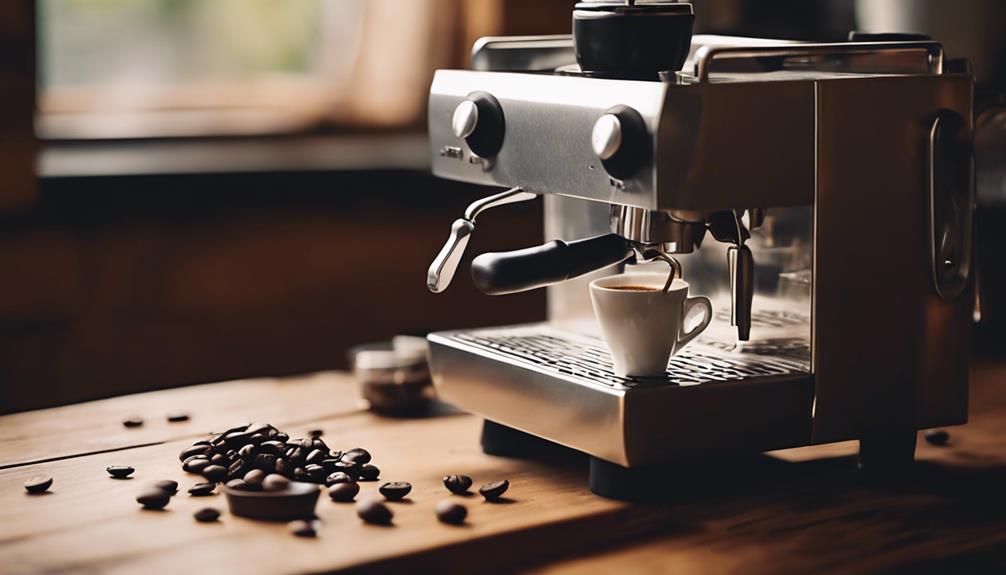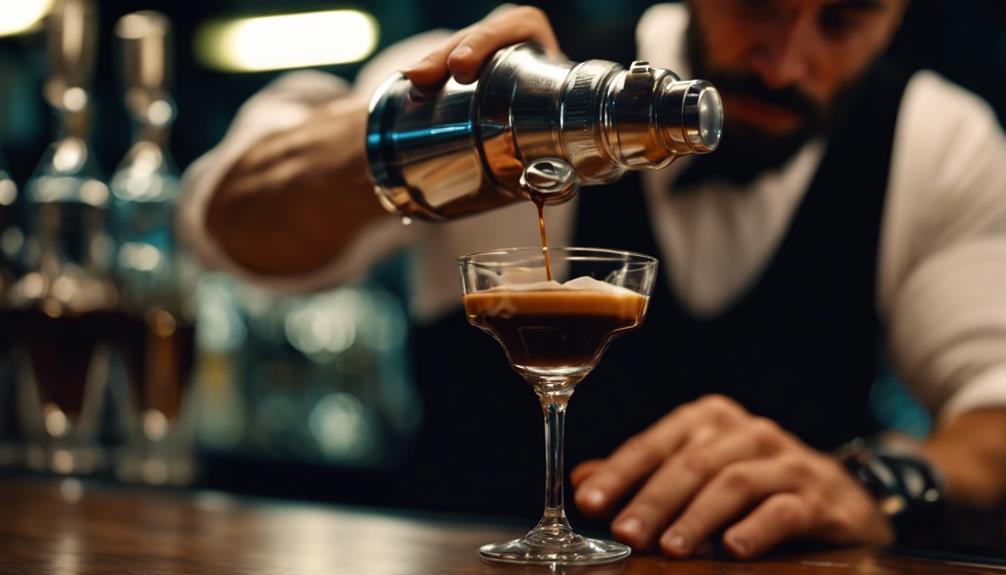Glass espresso cups offer a variety of advantages for your espresso enjoyment. They are excellent at retaining heat, keeping your beverage warm for a longer period of time. The clear glass allows for beautiful latte art to be displayed, adding visual appeal to your drink. By swirling your espresso in these cups, the aroma is enhanced, making each sip more exciting. The design is nose-friendly, ensuring a comfortable drinking experience that enhances your sensory pleasure. Each cup is crafted with elegance by skilled artisans, making them unique and sophisticated. Additionally, the aesthetic appeal of glass cups brings a touch of sophistication to your coffee routines. Learn more about how glass espresso cups can enhance your coffee experience.
Key Takeaways
- Enhanced heat retention for prolonged enjoyment of espresso.
- Ideal for showcasing vibrant latte art creations.
- Easy swirling to amplify aroma and flavor.
- Ergonomic design for comfortable sensory experience.
- Hand-blown elegance with unique light reflections.
Heat Retention for Longer Enjoyment
Glass espresso cups excel at retaining heat, guaranteeing your espresso stays hot for an extended period, perfect for savoring your drink slowly. Compared to ceramic or plastic alternatives, glass cups provide superior heat insulation. This feature allows you to enjoy your espresso over a longer period of time without worrying about it cooling down quickly.
The ability of glass to trap heat inside the cup ensures a consistently warm espresso experience, maintaining the ideal temperature for your enjoyment. By choosing glass espresso cups, you enhance the overall espresso-drinking experience by keeping your drink warm for an extended duration.
Whether you prefer to leisurely sip your espresso or take your time to appreciate the flavors, the heat-retention properties of glass cups contribute significantly to prolonging the enjoyment of your drink. This durability in maintaining warmth sets glass espresso cups apart, making them a practical and efficient choice for coffee enthusiasts who value a prolonged hot espresso experience.
Showcasing Latte Art Beautifully

Enhance the visual appeal of your latte art creations by presenting them in glass espresso cups, allowing the vibrant colors of espresso and milk to shine through. The open shape of glass cups provides a perfect canvas for showcasing intricate designs, making them ideal for baristas aiming to impress with their latte art skills. The transparency of glass enhances the presentation, showcasing the details of the design clearly. Customers and coffee enthusiasts alike are often impressed by the elegance and sophistication added to lattes served in glass cups.
When a well-crafted latte design meets a glass espresso cup, the result is a visually stunning beverage that isn't only Instagram-worthy but also a delight for both the eyes and the taste buds. The combination of the colorful layers of espresso and milk in a transparent vessel creates an enthralling visual experience that elevates the enjoyment of your latte art creation.
Easy Swirling for Enhanced Aroma

When enjoying your espresso in glass cups, you'll find that easy swirling enhances the aroma of the coffee, intensifying its fragrance effortlessly.
Glass espresso cups are designed to allow for smooth swirling motions, which help release the full potential of the espresso's aroma.
By swirling the espresso in a glass cup, you aerate the coffee, intensifying its fragrance and creating a more immersive sensory experience.
This simple yet effective technique not only amplifies the overall aroma but also helps in detecting subtle notes and flavors present in the espresso.
Coffee enthusiasts particularly appreciate the ability to swirl their espresso in glass cups, as it maximizes the enjoyment of the aromatic aspects of the coffee.
The design of glass cups promotes easy swirling, making it a favored choice for those looking to elevate their espresso experience through enhanced aroma.
Nose-Friendly Shape for Comfort

The ergonomic design of glass espresso cups with a nose-friendly shape guarantees comfortable sipping without interference from the rim. These cups are crafted to allow you to enjoy your espresso without having the rim disturb your nose, providing a seamless drinking experience.
By ensuring that the aroma of the espresso can easily reach your nose, the design enhances the overall sensory enjoyment of the drink. This feature maximizes your ability to perceive the full range of fragrances present in the espresso, leading to a more immersive tasting experience.
With a nose-friendly shape, glass espresso cups enable you to appreciate the intricate fragrance and flavor profile of your drink more thoroughly. The ergonomic design of these cups not only contributes to comfort but also plays an essential role in enhancing your overall espresso-drinking experience.
Hand-Blown Uniqueness for Elegance
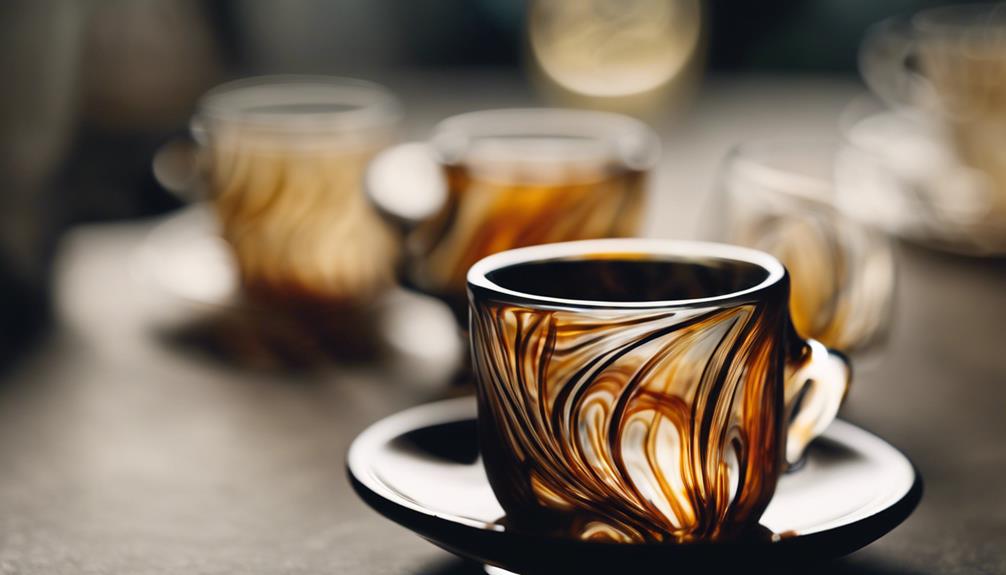
Crafted individually by skilled artisans, hand-blown glass espresso cups boast a unique and elegant design. These cups aren't mass-produced; each one is a work of art with slight variations in shape, thickness, and patterns. The hand-blown process results in lightweight yet durable cups that feel comfortable in your hand as you savor your espresso.
The intricate details and delicate craftsmanship of hand-blown glass espresso cups set them apart, making them exquisite pieces that add a touch of sophistication to your coffee routine. The artistic appeal and one-of-a-kind beauty of these cups make them highly sought after by coffee enthusiasts looking for a luxurious touch.
When you choose hand-blown glass espresso cups, you're not just getting a vessel for your coffee – you're investing in a piece that embodies elegance and uniqueness, elevating your espresso-drinking experience to a new level of refinement.
Indulgent Espresso Experience Enhancement

Glass espresso cups guarantee a dual benefit of enhancing both the aesthetics and functionality of your espresso experience.
With their heat retention properties, these cups ensure your espresso stays at the perfect temperature for longer, allowing you to savor every sip.
The combination of aesthetics and functionality in glass espresso cups elevates your indulgent espresso experience to new heights.
Aesthetics and Functionality
In addition to enhancing your espresso experience with both aesthetic appeal and functional design, glass espresso cups offer a luxurious touch to your daily coffee ritual.
The transparent nature of glass cups allows you to admire the rich crema and vibrant hues of your espresso, elevating the visual aspect of your coffee enjoyment. Additionally, the see-through design enables you to appreciate the layers and textures of your espresso, heightening the indulgent sensory experience.
Baristas and coffee aficionados favor glass espresso cups for their smooth surface, perfect for showcasing intricate latte art designs. The open shape of these cups also facilitates easy swirling and aroma release, enhancing the overall tasting experience of your espresso.
Besides, the nose-friendly feature of glass cups lets you fully immerse yourself in the aromatic complexities of your coffee, creating a truly luxurious and satisfying moment with every sip.
Heat Retention Properties
Experience a heightened level of indulgence in your espresso enjoyment through the exceptional heat retention properties of glass espresso cups. Glass cups excel at keeping your espresso hot for a longer time, guaranteeing that each sip maintains the perfect temperature for a more satisfying drinking experience. The superior heat insulation of glass traps heat effectively, preserving the flavor and aroma of your espresso shots. With glass cups, you can enjoy the full richness of your espresso, as they maintain the ideal drinking temperature throughout. These heat retention properties enhance the overall enjoyment of your espresso, allowing you to savor every sip at the ideal warmth.
| Benefits of Glass Espresso Cups |
|---|
| Retains heat effectively |
| Preserves flavor and aroma |
| Maintains perfect temperature |
| Enhances espresso enjoyment |
| Ensures ideal warmth |
Aesthetically Pleasing Design Features
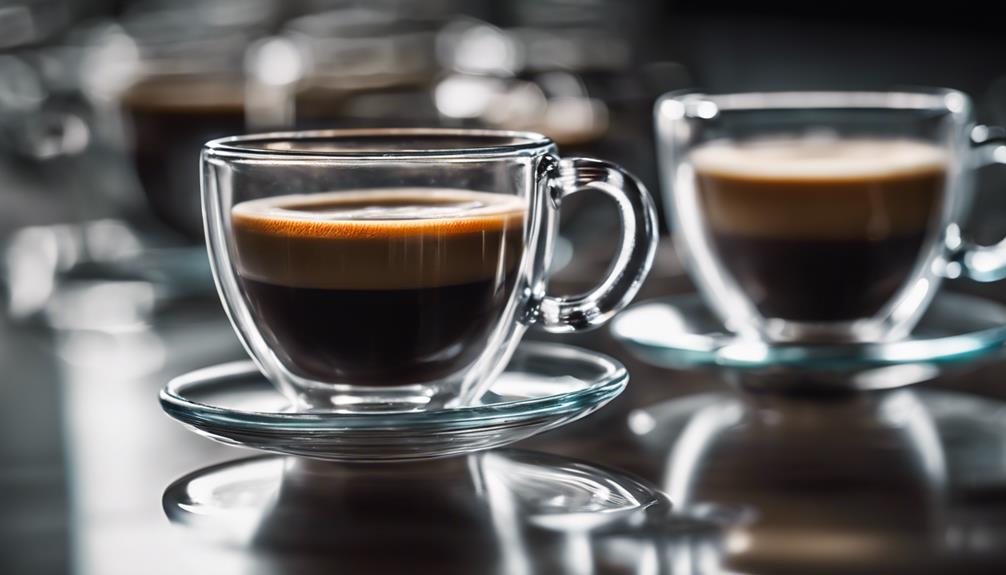
Glass espresso cups boast elegant transparent aesthetics that showcase the rich colors of espresso and intricate latte art designs. Their versatile modern shapes add a contemporary flair to your coffee experience, while unique light reflections enhance the visual appeal of your drink.
These design features not only elevate the presentation of your espresso but also contribute to a sophisticated and aesthetically pleasing ambiance.
Elegant Transparent Aesthetics
The elegant transparency of glass espresso cups effortlessly showcases the rich color and crema of your espresso, elevating the visual appeal of your coffee experience. When you pour your espresso into a glass cup, you can admire the deep brown hues and the creamy layer on top.
This transparency not only enhances the presentation of your coffee but also allows you to appreciate the artistry of your barista's pour. The sleek and clear design of glass cups adds a touch of sophistication to your coffee rituals, making each sip a visually pleasing experience.
Whether you're enjoying a classic espresso shot or a beautifully crafted latte, the elegant aesthetics of glass cups complement the art of specialty coffee drinks. With glass espresso cups, you can savor the full aroma and flavor profile of your espresso without any interference, as they're designed to be nose-friendly for a complete sensory experience.
Versatile Modern Shapes
Featuring a range of sleek and contemporary designs, glass espresso cups offer a stylish addition to your coffee collection. These cups come in various modern and versatile shapes, adding a touch of sophistication to your coffee-drinking experience. The open design of glass espresso cups allows for intricate latte art to be showcased beautifully, enhancing the visual appeal of your morning brew.
| Benefits of Glass Espresso Cups | Description |
|---|---|
| Artisanal Aesthetic | Hand-blown glass espresso cups provide a unique and artisanal look, perfect for coffee enthusiasts. |
| Aroma Enhancement | Nose-friendly designs in glass espresso cups enhance the aroma of your coffee, elevating the sensory experience. |
| Flavor Release | Swirling ease in glass espresso cups helps release the full flavor profile of your espresso, making each sip more enjoyable. |
These cups not only look great but also contribute to the overall enjoyment of your coffee by enhancing its aroma and flavor.
Unique Light Reflections
Enhancing your coffee-drinking experience, unique light reflections created by glass espresso cups add an aesthetically pleasing dimension to your morning brew.
The way light interacts with the transparent design of glass cups not only showcases the rich crema layer of your espresso but also refracts in a mesmerizing manner, playing with colors and textures that elevate the visual appeal of your coffee.
This distinctive feature makes glass espresso cups perfect for displaying intricate latte art, as the light enhances the details of the coffee and milk foam design.
The overall aesthetic charm of glass espresso cups brings an elegant touch to your coffee ritual, making each sip not only flavorful but visually delightful.
The play of light and shadows, coupled with the sleek design of glass, creates a sophisticated presentation that enhances the enjoyment of your espresso, making it a feast for both your taste buds and your eyes.
Frequently Asked Questions
Why Do People Use Glass Coffee Cups?
People use glass coffee cups for various reasons. The transparency of glass showcases the layers and crema of espresso drinks, enhancing the visual appeal.
Glass allows drinkers to appreciate the color, texture, and aroma of their coffee, elevating the sensory experience.
Baristas often prefer glass cups for serving espresso due to their elegant look and heat retention properties.
What Do You Use Espresso Glass For?
You use espresso glass cups to showcase the crema and color of your espresso, appreciating its aroma and visual appeal. These cups are designed for single or double shots of espresso, commonly seen in cafes to elevate the presentation of espresso-based drinks.
The transparent nature of glass cups lets you observe the layers and textures of your espresso, enhancing the sensory experience. They also help maintain the best temperature of your espresso for a consistent taste with each sip.
Why Use Espresso Cups?
You use espresso cups to enhance your coffee experience. Glass cups showcase crema and colors beautifully, letting you observe quality easily. They don't hold onto flavors, ensuring a pure taste.
With good heat retention, your espresso stays hot longer. Glass cups offer a classy touch to serving espresso.
When Were Espresso Cups Invented?
Espresso cups were first invented in the early 20th century in Italy. They were designed to serve the concentrated coffee shot in a small-sized vessel, typically 2-3 oz. These cups evolved to retain heat and showcase the crema layer on top, with traditional materials like ceramic or porcelain.
Modern espresso cups now offer various options, including glass, stainless steel, and silicone, each impacting the aroma and taste of the espresso shot differently.
Are Glass Espresso Cups Heavier and More Durable Than Other Materials?
When it comes to espresso cup weight factors, glass cups tend to be lighter than materials like ceramic or metal. However, this doesn’t necessarily make them less durable. In fact, many glass espresso cups are designed to be sturdy and resistant to cracks or chips, making them a popular choice for coffee lovers.
How Can Glass Espresso Cups Benefit My Espresso Drinking Experience?
When it comes to understanding espresso cup capacity, glass espresso cups can make a significant difference in your drinking experience. The transparency of the glass allows you to appreciate the rich color and crema of your espresso, while the heat-retaining properties of the material keep your drink at the perfect temperature.
Conclusion
To sum up, glass espresso cups offer a plethora of benefits that enhance your coffee experience. From superior heat retention to showcasing latte art beautifully, these cups elevate your indulgence to a whole new level.
The elegant hand-blown design adds a touch of sophistication to your morning routine, making each sip a luxurious experience.
Treat yourself to the ultimate espresso enjoyment with these aesthetically pleasing and functional cups.
